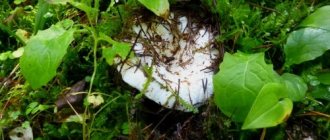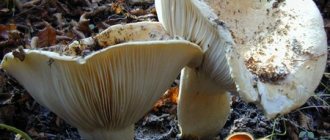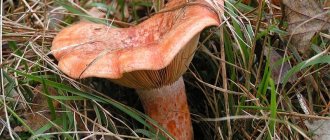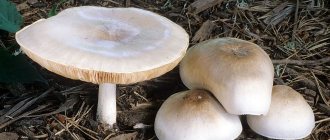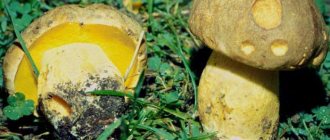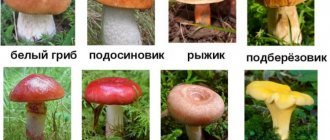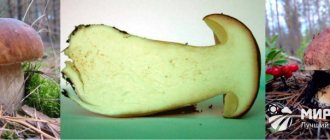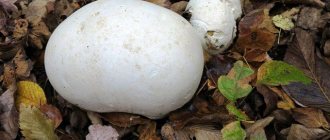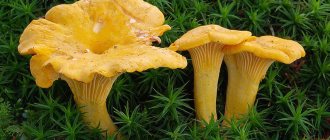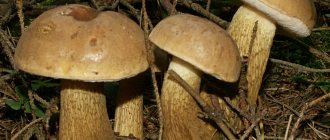For an experienced mushroom picker, the question of how a milk mushroom differs from a squeaky mushroom will not be a reason for long thought. He knows very well all the differences that make it possible to eliminate the risk of inedible and poisonous specimens ending up in the basket. We invite you to learn how to distinguish white milk mushroom from mustard, violin, volnushka, row and other mushrooms that are similar in appearance. The page provides comparative characteristics and full descriptions of similar types of mushrooms. Be sure to look at how to distinguish white milk mushrooms from false ones in the photo, which illustrates all the typical signs. This will help you feel more confident during a “quiet hunt” in the forest. Pick mushrooms very carefully. Recently, cases of poisoning from eating seemingly familiar types of mushrooms have become more frequent. In fact, there is active mimicry and poisonous mushrooms become very similar to edible ones in appearance.
Are there false milk mushrooms, poisonous, what do they look like, how to distinguish them from real ones?
Among the large assortment of edible types of mushrooms, milk mushrooms are given one of the first places.
There is no mushroom picker who can bypass this mushroom, since it is distinguished by its rather bright and nutritious taste. It’s a shame, but you can often find false squeaky mushrooms, which have a number of distinctive features. In addition, the papillary milk mushroom may end up in the basket. It can cause quite serious poisoning.
False breast
If you want to understand what exactly this mushroom looks like, you need to see a real one in person. You also need to get acquainted with the main distinguishing features and compare these features with the appearance of false mushrooms.
- The initial appearance of the cap of an edible mushroom is this: the cap is convex and has curled edges. Over time, the cap takes on a different shape. Its edges rise, creating a funnel shape in the central part.
- The cap of the edible mushroom is moist and quite dense. May have a white or cream color. As a rule, it is covered with twigs, dirt, and mucus.
- The plates of the edible mushroom are white, with yellow edges. The edges themselves are wide or quite loose. If you take a false mushroom, then it has dense, hard and thick plates that look unnatural. Often, it is thanks to the plates that one can distinguish a real milk mushroom from a poisonous one.
- Real milk mushrooms have a large amount of milky juice.
- The edible mushroom has only white flesh.
Milk mushroom is a mushroom that has a large number of false twins. But many of these mushrooms are considered conditionally edible, since according to certain characteristics they are similar to real ones.
Edibility
White milk mushroom.
In Europe, milk mushrooms are classified as inedible mushrooms. In our country, it is allowed to be eaten after long-term culinary processing: soaking in a saline solution, boiling to remove the bitter taste and subsequent salting. Drying, frying and using them for preparing first courses is highly not recommended. Milk mushrooms have a third category of edibility. The methods chosen for culinary processing directly depend only on the taste preferences of the housewives.
If the mushroom is old, then it is better to avoid eating it; it can be life-threatening. It is better for novice mushroom pickers to take a more experienced consultant with them to avoid unpleasant consequences.
Mushrooms are subject to variability. The same type of mushroom, which grows in different conditions (temperature and soil composition), gives different indicators in laboratory studies in terms of toxicity.
Dry milk mushrooms in cooking
Dry milk mushrooms are consumed:
- in pickled form;
- in salted form.
Before cooking, the milk mushrooms (dry milk mushrooms) are soaked in cold water for 5 hours. Then they are boiled in salt water. Then place it in cold water again.
Salt in 2 ways:
- Quick: dry milk mushrooms are boiled for 20 minutes, adding salt and spices to taste. Add citric acid or vinegar to prevent the product from fermenting. Place the mushrooms in a bowl of cold water to cool. After 10-15 minutes they will be ready to eat.
- For long-term storage: place the mushrooms in several layers in a container suitable for this purpose. If you take an enamel container, it should not have chips in the enamel. Each layer is salted and finally filled with water. The product is left under water and moved to a place at room temperature. When foam stops forming, the product is washed. The mushrooms are placed in containers (jars) and filled with salt water. Storage conditions: cold place. A refrigerator or cellar is suitable.
Cook for up to 20 minutes, constantly skimming off the foam. Next, the mass is dried and placed either in jars, bags, or special containers. Store in the freezer for up to 10 months.
Caviar from loads
- mushrooms - 2 kg;
- carrots - 0.5 kg;
- onion - 0.5 kg;
- pepper;
- salt;
- vinegar 6% - 5 tbsp. l.;
- vegetable oil.
Initially, the vegetables are peeled, washed and ground. They are fried in a frying pan with vegetable oil and poured into a saucepan to simmer.
The loads are finely chopped or used in a meat grinder. The mixture is poured into the vegetables, and 0.5 tbsp is added. l. vegetable oil, simmer for 40 minutes, stirring occasionally.
Add spices and simmer for another 10 minutes. At the end, add vinegar, stir and immediately pour the mixture into jars. Roll up, allow to cool and move to a cool, dark place.
Marinated mushrooms in tomato
To prepare you will need the following ingredients:
- water - 500 ml;
- bay leaf - 2 pcs.;
- vinegar - 2 tbsp. l.;
- spices - to taste;
- garlic - 2-3 cloves;
- vegetable oil;
- tomato juice, or paste, or ketchup - 250-350 g;
- mushrooms - 1.5 kg.
The main product is fried, ketchup, tomato paste or juice, water are added, and mixed. Next add spices and garlic passed through a press. Laurel leaves are thrown. Simmer for 0.5 hours, then add vinegar. Simmer for another 10 minutes, remove the bay leaves from the container. The mass is distributed into sterilized jars, leaving a free space of 1.5 cm from the neck of the jar. Sterilize 0.5 liter jars for 40 minutes, 1 liter jars for 1 hour and then roll them up. The cooled dish is transferred to a cool and dark place.
Is it possible to fry creaks. Pickling squeaky mushrooms
- The creak mushroom is considered conditionally edible, so most often it is collected only in those years when the mushroom harvest is not encouraging. Squeaks grow almost everywhere, in large groups, but in their unprocessed form they are very bitter, so they need long-term processing. The best cooking method is pickling.
- Number of servings: 5
- Cooking time: 24 minutes
Salted squeaky mushrooms can be used for preparing holiday dishes
Photo: Getty
Recipe for cold pickling of squeaky mushrooms
Before salting, the creaks need to be soaked well under pressure for 5 days to remove the bitterness. But you must ensure that the water does not become sour and change it regularly. If you fill the mushrooms with boiling water rather than cold water, the soaking time is reduced to 2-3 days.
Banks need to be prepared especially carefully. They must be washed with water and soda, rinsed well and sterilized over steam for 20 minutes. Plastic lids need to be boiled for at least 2 minutes.
Preparation:
- Fill prepared clean jars tightly with mushrooms, caps down, sprinkling them with salt. Since the creaks have been soaked for a long time, when placed in a jar they will release liquid, which should cover them completely.
- If desired, you can add cloves and bay leaves.
- It is advisable to cover the top of the jars with currant leaves to prevent mold.
Store jars in the refrigerator for 7 weeks. During this time, the bitterness should completely go away. The duration of pickling depends on the pulp: in old mushrooms it is hard, so it will take longer to pickle. If the brine level decreases, fresh water and salt must be added to the jars (per 1 liter - 20 g).
Recipe for making salted squeaky mushrooms using the hot method
Mushrooms prepared in this way acquire a pleasant crunchiness, elasticity and aroma of milk mushrooms.
Ingredients:
- creaks – 2 kg;
- salt – 60 g;
- currant leaves – 20 pcs.
Preparation:
- Blanch pre-soaked mushrooms in an enamel container for 20 minutes, constantly skimming off any foam that appears. If they are too large, this time should be increased to at least 1/2 hour.
- Place the squeaks in a colander to remove excess liquid. Place currant leaves in a thick layer on the bottom of sterilized jars.
- Place the mushrooms tightly in jars, caps down, sprinkle with salt.
- Cover the top with currant leaves and close with plastic lids.
Store in a cool place for 1.5 months.
When properly salted, the squeaks turn out to be quite tasty, and they can then be used to prepare various dishes.
Gorchak
Description
More similar to boletus, sometimes it is confused with boletus.
It is inedible because no measures can remove the bitter, nasty taste. If at least one representative gets into the soup, the dish will be spoiled irrevocably.
The bitterness does not break down during heat treatment, but is enhanced many times over.
If a specimen was found near a rotten stump and was never bitten by anyone, despite its impressive size, then rest assured that it is a bitterling.
How is it different from milk mushrooms?
It does not look like milk mushroom at all; it is impossible to confuse it with agaric mushrooms.
Externally, it slightly matches the white one: it is also stocky, stands confidently on a strong thick leg, the inside of the cap is spongy.
You can distinguish it only by taste. It is enough to lightly lick the edge - if you feel bitterness, you should immediately rinse your mouth and throw the mushroom away.
Also pay attention to the stem on the cut: in bitterling it turns pink
Some common lookalikes
Milk mushrooms and other conditionally edible mushrooms of this family are not poisonous, but not very pleasant to the taste buds. People preparatory process the mushrooms, then cook them. The milk mushrooms are soaked and boiled for a long time with salt.
Pepper milk mushroom
The fruiting body of the mushroom is creamy-white; in mature specimens, the cap has the shape of a funnel with many gills. When pressed, it bleeds whitish milk with a peppery taste. Widely distributed in Europe, the Black Sea region in northeastern Turkey, eastern North America, and introduced to Australia. Forms a symbiotic relationship with deciduous trees, including beech and hazel, and grows in the soil from summer to early winter.
Mycologists consider it inedible and poisonous; culinary experts do not recommend it because of its taste. In its raw form, difficult to digest. In folk practice, it is used as a seasoning after drying, boiled, fried in butter, pickled, baked in dough.
The mushroom is prized in Russia. People harvest pepper milk mushrooms during the dry season, when other edible mushrooms are less available. In Finland, cooks boil mushrooms many times and drain the water. The latter is stored in chilled salted water all winter, pickled or served in salads.
Eating fresh and raw mushrooms irritates the lips and tongue; the reaction goes away within an hour.
Camphor milkweed (camphor milkweed)
They appreciate it for its smell. Cooks use it as a spice, not for cooking. The size of the camphor milkweed is small to medium, the cap is less than 5 cm in diameter. Color ranges from orange to orange-red and brown. The shape of the cap is convex in young specimens, flat and slightly depressed in mature mushrooms.
The fruiting body is fragile and brittle, secretes a whitish and watery-looking milk, similar to whey or skim milk. The juice has a mild or slightly sweet taste, but is not bitter or acrid. The smell of the mushroom has been compared to maple syrup, camphor, curry, fenugreek, and burnt sugar. The aroma is weak in fresh samples, becoming strong when the fruit body dries out.
Dried mushrooms are ground into powder or infused in hot milk. Some people use L. camphoratus to make a smoking mixture.
Violin (felt weight)
This is a fairly large mushroom found near beech trees. The fruiting body is dense, non-fibrous, and when damaged, the fungus releases colostrum. Mature specimens have caps from white to cream color, funnel-shaped, up to 25 cm in diameter. The wide stem is shorter than the fruiting body. The gills are distant from each other, narrow, with brown spots from dried juice. The spore print is white.
The mushroom is collected in deciduous forests from late summer to early winter. Milk juice has a neutral taste on its own, but is spicy if consumed with pulp. In the West, felt milk mushroom is considered inedible due to its pungent taste. In Russia, before cooking, they soak for a long time, then salt.
Golden-yellow milkweed (golden milkweed)
It is pale in color, poisonous, and grows in symbiosis with oak trees. The cap is 3–8 cm across, with dark markings of rough rings or stripes. At first it is convex, but later smoothes out; in older specimens there is a small central depression, the edges are without lint.
Popular articles Sansevieria flower - types and varieties, description
The whitish or pale yellow stalk is hollow, cylindrical or slightly swollen, sometimes pinkish on the lower half. The gills of the hymenophore are frequent, straight, with a pinkish tint, the spores are white-cream.
The whitish pulp has a pungent taste and is colored with abundantly secreted milk. Colostrum is initially white, but after a few seconds it turns bright sulfur yellow.
Golden milkweed appears in summer and autumn in the northern temperate zones of Europe, North America and North Africa.
Consumption results in predominantly acute, severe gastrointestinal symptoms.
White mushroom (dry mushroom): description, where it grows, photo
White milk cap (dry milk mushroom): description, distribution. How to distinguish pogruzdok white from other mushrooms. Collection, processing and preparation of dry milk mushrooms.
Mushrooms grow almost everywhere in the forest: under trees, on trees, living and dead. Pogruzdok white is a special mushroom. It grows almost underground, half dug into it, half covered with leaves. But if you are lucky enough to find one, a whole company will be waiting for you nearby - these gifts of the forest grow in large groups, which makes mushroom pickers incredibly happy.
Description
White Podgrudok (Russula delica) is a lamellar mushroom of the Russula family. In other words, it is called dry milk mushroom, cracker and excellent russula. It is called dry milk mushroom because it is very similar to the common milk mushroom, unlike which it always has a dry, non-sticky cap.
- The shape of the cap of a young fruiting body is convex with a depression in the center, the edges are turned down, later it becomes funnel-shaped with a smooth or wavy edge with a diameter of 5-15 cm bent downwards (see photo). The color of the white cap is pure white only when the mushroom is young; with age it turns yellow and becomes covered with yellow-brown and then ocher-rusty spots;
- the plates on the back of the cap are white, sometimes have a bluish-greenish tint, descending along the stem;
- the leg is white, with brown spots, short and thick, 3-5 cm in height and 1.5-3 cm in thickness, slightly narrowed downward. The inside is solid at first, but becomes hollow with age;
- The pulp is dense, fragile, does not change color when cut, and does not contain milky juice. The smell is pleasant, mushroom, slightly sweet in taste.
Dry milk mushrooms belong to the third category of edible mushrooms; they can be salted and pickled.
Spreading
Dry milk mushrooms are found from early summer to late autumn in all types of forests (deciduous, coniferous and mixed), even in mountains, forming mycorrhiza with oak, birch, beech, pine, spruce, aspen and alder. Most often they can be found near river banks, on soddy-sandy soils. They grow in small groups (less often singly). Distributed throughout Russia, but most often found in the north of the temperate zone.
Places and times of fruiting
Squeaky mushrooms grow almost everywhere, from the Far East to the regions of Western Europe. They are found in deciduous and coniferous forests, as well as mixed forest plantations. They can be collected in sunny forest glades, especially in the vicinity of birch and aspen trees. Mushrooms rarely grow alone; in most cases they form large groups.
Important! The time of maturation of squeaks depends on the climatic characteristics of the region. In central Russia, felt mushrooms ripen from mid-July to the end of October or the first days of November.
Violins collected in August and September are considered the most delicious and valuable.
Description of the mushroom
Ecology
The violin mushroom or squeaky mushroom is widespread on the Eurasian continent. It is found in most cases under birch and in mixed forests from July to September, often in large groups. In favorable years it produces large harvests.
hat
The diameter of the cap is from 8 to 24 cm. The color of the entire mushroom is milky white, slightly yellowing. The cap is up to 20 cm in diameter, very fleshy, dense, flat when young, then funnel-shaped, slightly pubescent, with yellow spots. The pulp has a very bitter taste. The milky sap is abundant, caustic, and slowly turns yellow in air. The plates descend along the stalk, white or cream, infrequent. Spore powder is white. The spores are almost round, with small spines.
The leg is short - up to 6 cm in length and up to 3.5 cm in thickness, dense.
Edibility
The creaking mushroom or spurge mushroom is conditionally edible
. Consumed salty. Before salting these mushrooms, they must be soaked in water for 3-5 days, draining it periodically. Or pour boiling water and change the water about 4 times a day. Then the process will take up to 3 days.
For an experienced mushroom picker, the question of how a milk mushroom differs from a squeaky mushroom will not be a reason for long thought. He knows very well all the differences that make it possible to eliminate the risk of inedible and poisonous specimens ending up in the basket. We invite you to learn how to distinguish white milk mushroom from mustard, violin, volnushka, row and other mushrooms that are similar in appearance. The page provides comparative characteristics and full descriptions of similar types of mushrooms. Be sure to look at how to distinguish white milk mushrooms from false ones in the photo, which illustrates all the typical signs. This will help you feel more confident during a “quiet hunt” in the forest. Pick mushrooms very carefully. Recently, cases of poisoning from eating seemingly familiar types of mushrooms have become more frequent. In fact, there is active mimicry and poisonous mushrooms become very similar to edible ones in appearance.
The cap is round, usually concave inward, funnel-shaped, white or yellowish in color, with large rusty spots, moist, slightly fluffy, with a large fringe along the edges. The plates are white, yellowish. The pulp is white, dense, juicy, thick, and secretes a bitter milky juice, especially when broken. The leg is short, white, hollow inside. They belong to the “plate” mushrooms, in which the lower part of the caps consists of delicate plates. Next, we will look at the main differences between milk mushrooms and a number of mushrooms that are similar in appearance.
Grows in birch forests and mixed forests with an admixture of birch. It is found quite rarely, but sometimes in large groups, from July to October. The cap is large, up to 20 cm in diameter, in young mushrooms it is white, rounded-convex, then funnel-shaped, with a shaggy edge turned down, white or slightly yellowish, often with faintly noticeable watery concentric stripes. In damp weather it is mucous, which is why this mushroom is called “raw milk mushroom”. The pulp is white, dense, brittle, with a spicy odor.
The plates descending along the stalk, white or cream, with a yellowish edge, wide, sparse. The stem is short, thick, bare, white, sometimes with yellowish spots, and in mature mushrooms it is hollow inside. Conditionally edible, first category. Used for pickling, less often for pickling. Salted milk mushrooms have a bluish tint.
Differences between violin and milk mushroom
Quite often found in coniferous and deciduous forests of the middle zone, in large groups, from mid-June to mid-September. The cap is up to 20 cm in diameter, at first flat-convex, depressed in the middle, with a curled edge. The difference between the violin and the milk mushroom is that later the cap becomes funnel-shaped with a wavy, often cracked edge. The surface is dry, slightly pubescent, pure white, later slightly buffy. The plates are sparse, whitish or yellowish. The leg is up to 6 cm long, thick, somewhat narrowed at the base, solid, white. The pulp is coarse, dense, white, later yellowish, with abundant white, pungent, pungent milky juice. The collected mushrooms in the basket rub against each other and make a characteristic creaking sound. For this they were called “violinists”, “creakers”. Mushroom pickers do not always take these mushrooms, although they are used for salting, becoming strong and acquiring a mushroom smell. The mushroom becomes white with a bluish tint and squeaks on the teeth. The mushroom is conditionally edible, category four. Used for salting and pickling. It must first be soaked and boiled to remove bitterness.
Differences from other mushrooms
According to the description, there are many false varieties of real milk mushrooms. Many of them are eaten, but some are poisonous.
Difference from a creaker
It is difficult even for an experienced specialist to distinguish a white milk mushroom from a squeaky one.
Skripun is edible, similar to white milk mushroom, but the taste is different. It also has beneficial properties. Main differences:
- it is called creaking because of the special creaking sound when parts of the fruiting bodies come into contact;
- these false doubles appear later than the real ones;
- worms settle only in white milk mushrooms; they do not grow in the flesh of the squeaky mushroom;
- the plates are less fleshy, lighter and thinner in white.
Difference from dry milk mushrooms
False black milk mushroom is popularly called “nigella”, “dry” or “chameleon”.
It has a different cap color depending on the age of the mushroom. Initially it is white, but over time it turns brown. There is no milky juice. Features of dry milk mushroom:
- needs a well-lit place;
- lives in mixed and birch forests;
- the cap is dry;
- the hole at the top is deeper.
Difference from bitterling, or pepper milk mushroom
The white milk mushroom differs from the false milk mushroom in its place of growth. Gorchak is found in the North in forests. Grows in well-moistened places in large groups.
Irina Selyutina (Biologist):
The pepper milk mushroom is characterized by a creamy white dry cap in the shape of a funnel, as well as an abundant secretion of white milky juice, which turns bluish or olive-green in air and a specific, very hot peppery taste that disappears only after thorough soaking.
The cap is up to 8 cm in diameter. The surface is flat, convex in young organisms, and funnel-shaped in mature ones. The plates are pale, yellow and red, with a coating. The stem is up to 8 cm. The milky juice is bitter. The taste is pungent and bitter, which is why this mushroom is only salted. It is classified as conditionally edible.
Difference from thin pig
The thin pig is a poisonous species, poisoning with it leads to death. Symptoms appear several hours after eating this mushroom.
The difference between a real mushroom and a pig in a hat, which has its own characteristics:
- size – up to 20 cm;
- the edges are directed inward;
- covered with fine hairs;
- color olive, brown, yellow.
Popular articles Why do anthurium have brown spots on its leaves?
Irina Selyutina (Biologist):
Upon careful examination of the underside of the cap of the thin pigtail, or rather the hymenophore, you will notice that it is folded and not lamellar, although it is often described in various sources as lamellar. It is formed not by real, but by pseudoplates. It is easy to separate from the surface of the cap, which is not possible with real plates. The color of the pseudoplates is usually lighter than the color of the cap. When subjected to mechanical action - pressure - they darken.
The flesh of the pig is brown; it darkens at the cut site. The leg is up to 9 cm, directed to the side. Tapers towards the soil. Collection takes place from mid-summer to mid-autumn.
The false milk mushroom is larger and has a brown stem. It accumulates a large amount of heavy metals.
There are false varieties of real milk mushrooms
Difference from spruce row
The difference from the spruce row is in the pulp. It is more elastic, white, smells like flour, tastes fresh. The plates of the false mushroom are white, then (as the mushroom grows) they become yellow or blue.
The leg of the row reaches a height of 10 cm and a width of 2 cm. It is smooth and white. The row is edible and is used to prepare many dishes.
Grows in coniferous forests from late summer until the first cold weather. The groups are small. Rarely collected. The size of the cap reaches 10 cm. The surface is sticky and gray in color. The center is darker than the edges.
Difference from whitefishes
Whitefish grow in the Center, North, West, and also in the Urals. Harvesting begins from the first days of August until mid-autumn. One of the differences is the appearance of the cap. The white cap has a diameter of up to 6 cm, velvety, white with red spots.
The main difference is in the pulp; in a real mushroom it is always white, while in a mushroom it is pink. The size of the white cap is smaller and has drooping bare edges. It is used only for salting; it must be carefully prepared beforehand.
Difference from the pale grebe
The toadstool has a slight thickening near the base of the leg. The appearance is more like russula.
The toadstool's cap can be olive green or white. Directly below the cap there is a ring on the stem.
Difference from milky
The milkweed looks like a white milk mushroom. This is a poisonous species and its consumption leads to death. The cap is up to 12 cm in size. It is fleshy, convex and funnel-shaped.
The edges are initially folded and droop with age. Old milkweed is red or pink. The leg reaches 8 cm in length and 4 cm in width. It is found from mid-summer to early autumn.
Differences between white milk mushroom and white milk mushroom
In the northwestern and central regions of the country and in the Urals, usually on the edges of young birch forests from the beginning of August to October you can find the white moth. It is in many ways similar to the pink wave, but smaller. The difference between the white milk mushroom and the white milk mushroom is as follows: the cap, up to 6 cm in diameter, is fluffy-silky, at first convex, later funnel-shaped, white with yellowish-reddish, blurry spots, with a curled hairy edge.
The white milky juice is pungent and sometimes bitter. The plates are light fawn, slightly pinkish, adherent or descending, frequent, narrow. The leg is dense, brittle, short, smooth. The difference between milk mushrooms and milk mushrooms is that their flesh is always white, and not slightly pinkish. Belyanka is sometimes confused with white podgruzdka. But the latter has a much larger cap, and the edge is bare or slightly pubescent. It is only used for pickling after preliminary soaking in water or scalding with boiling water. Belyanka is valued for its delicate pulp and pleasant taste. When salted it is light brownish.
The best recipes for preparing dishes and preparations
Salted milk mushrooms
All milk mushrooms are suitable for food after soaking for two to three days, and the water is changed several times, adding fresh water. This is the only way to get rid of the bitter taste of pulp and acrid juice. Pickled fruit bodies are not only an exceptionally tasty snack, they are an excellent preparation for first courses and stewing.
Pickled black milk mushrooms
For 5 kg of prepared mushrooms, take 200 g of salt, blackcurrant leaves, garlic, dill, black peppercorns and other herbs and spices to taste.
Pickles can be prepared using the cold method, and then the preparation will be more tasty, and using the hot, faster method.
Cold salting
The cleaned fruiting bodies are immersed in cold water for three days, which is replaced several times a day. After this, they are placed with their caps down in a vessel, sprinkling the rows with salt and spices, covered with a cloth and a load is placed. The shelf life of pickles is 30–45 days.
Hot salting
The mushrooms are boiled until tender and placed in a suitable container, sprinkled with salt, spices and pressed down with a weight, as in the previous case. With this method, the pickles are prepared for two weeks.
Canned pickles
For one liter jar of preserves, take 4 tablespoons of 5% vinegar, salt, black pepper, and several bay leaves. Prepare hot brine at the rate of 20 g of salt per 1 liter of water.
Mushrooms salted for 30–45 days are placed in a colander, inspected, removing damaged fruiting bodies, and washed with running water. As soon as the water has completely drained, the workpiece is placed in jars on a layer of spices, then vinegar and the prepared hot brine are poured. The preservation is placed for sterilization, keeping the liquid in the jars at a boil for at least one hour, then sealed.
Pickled milk mushrooms
For 5 kg of prepared mushrooms take 200 g of salt, 300 g of sugar, 400 g of sour milk.
The fruiting bodies are cut into pieces, dipped in hot water, salted to taste, boiled for two minutes and drained in a colander. Place it in a vessel in layers, add salt, add sugar, press down, releasing excess air, and pour in sour milk, covering the fermentation with a cloth, and place a weight on top.
At a temperature of 17–19°C, the product can be consumed after two weeks. For long-term storage, the workpiece is packaged in jars, filled with brine at the rate of 20 g of salt per 1 liter of water and sterilized for 40–50 minutes, after which it is sealed.
Favorite in folk cooking, milk mushrooms, thanks to their inimitable aroma, excellent taste properties, and undoubted nutritional value, deserve the closest attention of mushroom pickers. Obvious advantages - excellent yield, absence of poisonous look-alikes and high transportability make this species one of the best trophies for lovers of “silent hunting”.
You will learn more about milk mushrooms and their distinctive features from the video.
Can it be grown at home or in the country?
Can!
Provided that you have a sufficient amount of mycelium, this process will not cause you any particular difficulties.
Algorithms of action and necessary components for successfully growing mushrooms, both for yourself and for sale:
A simple recipe for those who could not find ready-made mycelium for growing
- Find and collect very overripe mushrooms in the forest
- Break into small pieces
- Then mix with sawdust and peat
- Fertilize with nutrient solution
- Find a lid with small holes and cover it with it.
- Preheat the room to 23 degrees Celsius
- Leave for approximately three days in these conditions.
- Immediately before planting, take a lime solution and treat the soil with it (fifty grams of lime per 10 liters of water)
- Pre-prepare recesses near a deciduous tree
- Fill the hole halfway with the substrate that was previously prepared.
- Sprinkle with previously prepared soil with lime
- Cover with moss, placing rotten leaves on top
Recipe with mecelium, for those who were still able to get it =)
- Prepare a sufficient amount of hardwood sawdust and forest soil
- Mix soil and sawdust with mycelium
- In the forest where the violinist sprouts, collect moss and rotted leaves
- During the periods from late spring to early autumn, sow the mycelium of creaks
- Prepare a nutrient solution for feeding from nutritional yeast and sugar
- Feed at least once every 3 days
After sowing, the harvest can be harvested within about five years; taking into account the use of mycelium, you can also try growing the violin mushroom in the basement, garage or barn.
What is the difference between a false breast and a real one?
The first thing that distinguishes a false breast from a real one is a cap with a diameter of 4-12 cm, densely fleshy, convex or flat-spread to funnel-shaped, sometimes with a tubercle, initially with a bent edge, and later with a drooping edge, dry, silky-fibrous, finely scaly, with age almost naked, ocher-meaty-reddish, ocher-dirty-pinkish-gray or pinkish-brownish, with vague spots when drying.
The plates are descending, narrow, thin, whitish, later pinkish-cream and orange-ocher. The leg is 4-8×0.8–3.5 cm, cylindrical, dense, eventually hollow, tomentose, hairy-tomentose at the base, the color of the cap, lighter in the upper part, mealy. The pulp is yellowish with a reddish tint, the lower part of the stem is reddish-brownish, sweet, without much odor (when dried, it smells of coumarin); The milky juice is watery, sweet or bitter, and does not change color when exposed to air. Grows in moist coniferous and deciduous forests. Fruiting bodies are formed in July – October. Poisonous mushroom. Watch how to distinguish a white milk mushroom from a false one in the video, which shows all the features.
(function() { if (window.pluso)if (typeof window.pluso.start == "function") return; if (window.ifpluso==undefined) { window.ifpluso = 1; var d = document, s = d.createElement("script"), g = "getElementsByTagName"; s.type = "text/javascript"; s.charset="utf-8″; s.async = true; s.src = ("https:" == window.location.protocol ? "https" : "http") + "://share.pluso.ru/pluso-like.js"; var h=d("body"); h.appendChild(s) ; }})();
The mushroom, which is called the “violin mushroom,” often ends up in the basket with other mushrooms, since it is easily confused with the white milk mushroom. However, this mushroom differs in taste. And, nevertheless, many experienced mushroom pickers and ordinary amateurs are not against making preparations for the winter from creaks. Before salting milk mushrooms, you need to learn about the basic rules and subtleties of this process.
Squeaky milk mushrooms are classified as conditionally edible mushrooms. These forest products are preserved in pickled or salted form. Like other mushrooms that belong to the laticifers, creaks necessarily require pre-treatment.
First, you should thoroughly clean the surface of the mushroom cap from dirt - to do this, it is better to leave the product to soak overnight in a bowl of water. Afterwards you need to trim the leg under the cap. And only then put it on the fire and cook for at least 10 minutes.
Advice! It is better to soak the squeaks for several days, since this way the juice, which is harmful to humans, is washed out.
Preserving squeaks for the winter is notable for the fact that they can subsequently be used for many purposes: frying, stewing, adding to soups or salads. Therefore, salting is considered the optimal way to preserve forest products. Moreover, all cooking recipes will make this product safe for consumption.
The conservation procedure itself takes place in several stages:
- Preparatory work for processing the main ingredient. Skripuny should be sorted and separated from other varieties.
- Clear forest product. It is thoroughly washed to remove various contaminants, since it grows near stumps and mosses.
- Soak in cool water for several days. The fluid needs to be changed several times.
- Chop large milk mushrooms.
- Preservation by any available method: cold, hot or dry pickling.
Popular articles When and how to plant a tulip in August
Only by following the basic manufacturing technology can you prepare a dense, crispy and tasty squeaky snack for the winter.
Is it possible to eat squeaky mushrooms? Mushroom violin - characteristic features
The violin, like the real milk mushroom, is closely connected with the birch in its life.
The mushroom forms mycorrhiza with this tree, and grows in forests where there is always a birch tree. Usually these two mushrooms are found in almost the same areas of the forest. And quite often the mushroom picker is wrong. I was hoping for valuable loot... but what I got was a squeak!
Skripuny, skripukhi - these are even more common names than the “official” name of the mushroom - violin. The mushroom received them for its very characteristic creaking sound, which is heard, for example, when cutting the fruiting body.
What are the most obvious signs of violin mushroom?
Skripitsa is a dense mushroom, often quite large. The diameter of the cap of a mature fruiting body can reach 15–20 cm.
The young mushroom has an almost flat, white cap. Later it becomes funnel-shaped and acquires a yellowish tint. Yellow spots are often visible on the cap of a mature mushroom.
Mature fruiting body of a funnel-shaped violin mushroom
But there are no concentric circles, even if implicitly expressed, like in a real milk mushroom, on the violinist’s cap. The edge of the cap is usually turned up. But the “hairiness” of the edge, by which a real white breast is easily identified, is also not observed in the violinist.
And the surface of the violin mushroom cap is predominantly dry. Unless, of course, you are looking at a mushroom in the rain.
But on the cap there is usually quite a lot of forest debris stuck to it, which is not so easy to clean off.
The stem of the violin mushroom is short and thick, dense.
The violin leg is thick and rather short
The plates are descending, quite sparse and thick. The color of the plates can be white or pale yellow.
These are the plates of the violin mushroom
The cut exudes abundant white milky juice, which slowly turns yellow in the air. Drops of milky juice can also be seen on damaged plates. This juice tastes very bitter.
The violin has abundant bitter white milky juice, gradually turning yellow in the air
The violin mushroom is extremely rarely damaged by insect larvae. Fungus gnats don't like it! However, this does not mean that the mushroom is poisonous.
Comparison of the violin mushroom with similar mushrooms
The easiest way to distinguish between a violin and a real milk mushroom. These mushrooms are similar only from a distance, in their white color. Moreover, the milky juice of the violin and milk mushrooms is bitter, white, and yellowing.
The cap of a real milk mushroom is usually wet and slightly shaggy. There are noticeably more hairs along the edge. Concentric rings are visible on the surface.
This is what a real milk mushroom looks like
The violinist's hat is dry. There are no hairs. Concentric zones are not expressed.
Another bitter milkweed is similar to violin - pepper milk mushroom. I see him here quite rarely. It is predominantly an inhabitant of deciduous forests. But pepper mushrooms form mycorrhiza not only with oak, but also with birch.
Pepper milk mushrooms also have a very bitter milky juice. But in the air it does not turn yellow, but turns blue. And the plates of the pepper milk mushroom are more frequent than those of the violin.
And also, in my opinion, the bitterness of pepper milk mushrooms cannot be removed by any soaking or boiling. I remember soaking it for five days, but the mushroom remained bitter after salting!
Externally, many people are similar to the violin mushroom, white podgrudok, otherwise called “cracker”. The same large white funnel-shaped fruiting bodies. And there is always a lot of debris on the hat.
But there is no milky juice (hence the “cracker”). And there is absolutely no bitterness. And in general - the podgruzka belongs to another genus - Russula (i.e., Russula). And you can fry the loading immediately, only after bringing it from the forest. But more often than not, the “crackers” come across as extremely wormy.
Useful properties and possible harm of the creak
Scientific nutritionists do not recommend consuming this mushroom in its raw form, as it contains trace elements that irritate the gastrointestinal tract and cause vomiting. The bitter taste of a fresh violin is not eliminated even after heat treatment.
However, proper processing kills all pathogenic substances in the mushroom and brings in one serving of this dish the entire list of useful substances for the body: iron, phosphorus, potassium, sodium. The mushroom can also easily be called dietary due to its low calorie content, only 22 kcal per 100 grams.
With frequent use, felt milk mushrooms have a positive effect on such body processes as:
- Increasing the level of general immunity of the body
- Improves overall well-being
- Normalizes sugar and cholesterol in human blood
- Energy balance is restored
- Promotes the development of immunity to bacterial and viral diseases
The people of China, for example, use this in the prevention and elimination of pain in the tendons, pelvic limbs and joints.
But there are some contraindications before use:
- Gout
- Lactation period and pregnancy
- Various allergies
- Diseased kidneys and liver
- Various gastrointestinal diseases
It is not recommended for children under 12 years of age to eat it due to the high salt content and difficulty of digestion.
Who should not eat milk mushrooms?
Mushrooms are a valuable addition to a person’s daily menu due to the fact that they contain many active substances.
However, they can also cause some harm to the human body, since milk mushrooms are very dense in structure and take a long time to digest in the gastrointestinal tract, so the stomach may not have time to digest food that quickly enters it.
It is not recommended to use milk mushrooms simultaneously with:
- products that also contain protein;
- flour dishes;
- products containing starch;
- add animal fats to dishes with mushrooms.
Milk mushrooms must undergo special heat treatment to neutralize the poisonous milky juice in their composition
. They should be soaked, then boiled or fried. However, these mushrooms should not be fried for a long time, since such fried food is harmful to the intestines and liver.
You can’t eat milk mushrooms:
- for diseases of the gastrointestinal tract, especially for ulcers of the stomach and duodenum;
- at dinner, since milk mushrooms are a very heavy food;
- These conditionally edible mushrooms are strictly prohibited from being included in the menu of young children.
Description of mushrooms
False milk mushroom is a welcome guest on the holiday table, but not all housewives take up the preparation, preferring more familiar types. The reason for this is the white milky juice contained in the cap and stem, which can take on a yellowish tint in the air and has a sharp-bitter taste.
Real white milk mushrooms are considered the best for pickling.
Etymology of the name
There are different versions:
- The mushroom is named so because of its large weight, at which it appears heavy and heavy.
- The origin comes from the word “heap”, which means a lot.
Both options have the right to life, since some individuals reach decent sizes, massive due to the abundance of juice in the cap.
Peculiarities
Milk mushrooms grow in clusters or paths. Having found one specimen, you can be sure that you won’t be able to go home without some loot, you just need to carefully inspect the surrounding area.
The average temperature for the growth of milk mushrooms is 7-10℃. According to old mushroom pickers, it is best to start “hunting” for this mushroom after long, but not heavy rains. To collect, you will need a stick and a sharp knife.
They choose sunny clearings as habitats and do not hide in the shade. After rain, the cap becomes slippery, like a butternut cap, and the shape is always slightly concave, funnel-shaped.
Fruit bodies contain vitamin D of non-animal origin, and are also rich in protein (up to 30%), such an amount can replace meat.
Beneficial features
Mushrooms are recommended for those who are on a diet. Eating them regularly also helps:
- replenish mineral deficiency;
- increase immunity during epidemics and when there is a threat of tuberculosis, since the composition contains substances that resist Koch's bacillus;
- stabilize the nervous system;
- improve digestion;
- activate the process of removing toxins.
All milk mushrooms, including false ones, must be soaked to remove the bitterness from the milky juice. The difference in processing time is dictated by the characteristics of a particular species.
Where to look for edible milk mushrooms
Quiet hunting evokes excitement and captivates many people just as much as a real hunt. Mushroom pickers recommend getting up early so that you can be in the forest at sunrise. The best weather is drizzling rain or after rain. It’s good if in good weather you see dew on the grass: any moisture remains on the mushroom cap, thereby revealing its location.
To preserve the freshness and elasticity of mushrooms, it is recommended to place them in wicker baskets made of willow vine. In buckets, bags, packages, mushrooms will certainly lose their original appearance, and even in the absence of air in such containers they can simply “burn out”.
This mushroom basket will cheer up any “hunter”.
How to salt a violin at home
In search of the simplest, but at the same time delicious method of cooking, many people like to experiment with spices and various additives. You can choose dry, hot or cold preservation method. For a spicy, spicy taste, you can add garlic and pepper.
Hot marinating violin with currant leaves
Hot salting methods are usually very simple. And also, with this method of preservation, the duration of soaking mushrooms is reduced to two days. Many people neglect soaking, which as a result affects the taste of violins - they turn out with a bitter aftertaste. If you follow the recipe, this can be easily avoided. Ingredients:
- 1 kilogram of milk mushrooms;
- 30 grams of table salt;
- fresh currant leaves;
- filtered water.
How to prepare: prepare the main ingredient - sort and rinse thoroughly. Place in a bowl of water and soak for two days, changing the water several times. Then transfer them to an enamel bowl and boil the mushrooms. Add salt to the water. Simmer for 20 minutes, skim off foam periodically. Place in a colander and let all the liquid drain. Cool the main component.
Place fresh currant leaves in jars, and place the milk mushrooms with their caps on the bottom. Each new tier should be sprinkled with salt. Compact the milk mushrooms and place the currant leaves last. Place in a cool place to infuse. After a month you can use it.
How to salt skripukhi in a cold way
This method of preservation is in many ways similar to hot pickling of mushrooms. The cold method is also called the dry method, since no brine is prepared during the cooking process. If you do not follow the correct technology, the mushrooms will be unsuitable for consumption. Ingredients:
- 1 kilogram of squeaky mushrooms;
- 30 grams of salt;
- dill inflorescence;
- Bay leaf;
- allspice;
- 2 cloves of garlic;
- carnation.
How to prepare: clean and prepare the forest product - trim off spoiled areas, remove wormy mushrooms. Rinse and infuse the mushrooms in a bowl of filtered water for several days. Place the main component in a wooden container with the caps on the bottom. Add dill, garlic, bay leaf, pepper and cloves. Sprinkle with salt. Cover with a wide plate and put something heavy on top.
The creaks should be kept in this position for two days - this way they will release more liquid. If there is not enough water, you can pour in a little salt solution so that it completely covers the main ingredient.
How to marinate mushrooms with garlic
Marinated mushrooms with a garlic component are a spicy but at the same time savory appetizer for a holiday table or an addition to salads. This twist will acquire a pleasant aroma for the winter and become crispy. The effort and time spent are fully justified by this preparation with a special taste. Ingredients:
- 1 kilogram of milk mushrooms;
- liter of filtered water;
- fresh dill;
- currant leaves;
- allspice;
- 3 cloves of garlic;
- 4 tablespoons of salt.
How to prepare: rinse all ingredients. Prepare a container for marinating - a glass or wooden container is best. Aluminum or stainless steel containers are not suitable for this purpose. First, lay out the greens and allspice. Then a layer of creaks and garlic is laid out. Salt everything. After that comes another tier of herbs and garlic. Everything is covered with a wide plate and pressed down with something heavy. After a couple of days, the main component will settle and give a lot of juice. Move to a cool place and wait one month.
How to soak Podgruzdki?
Before cleaning, the milk mushrooms are transferred to a metal or plastic container, then filled with water. Cleaning begins about twenty minutes after pouring: during this time, the dirt particles will loosen a little, the stuck leaves and insects will fall off.
Interesting materials:
Can you paint with oil paint over acrylic paint? Is it possible to paint a plasterboard ceiling without putty? Is it possible to spin a hoop if you have uterine fibroids? Is it possible to eat coconut meat? Is it possible to eat before cardio? Is it possible to pour boiling water into an acrylic bathtub? Is it possible to simply pour boiling water over semolina? Is it possible to change Snils in another city? Is it possible to wash an acrylic bathtub with Pemolux? Is it possible to wash windows in frosty weather?
External characteristics and description of the mushroom
The fleshy body has a unique taste and smell. Also, the edible violin mushroom has the following distinctive features:
hat
- The structure is fleshy, dryish, with a felt surface, creaks when in contact with other objects
- The diameter of the cap changes during the ripening of the mushroom from 5 to 26 cm
- During the period of growing up, the shape of the cap changes from flat, or slightly protruding towards the center with low sides, to funnel-shaped with cracked edges
- The color changes its palette from milky to more saturated with a tint of ocher and interspersed with yellow spots
Hymenophore (lower part of the fleshy body)
- Has a plastic look
- Rare plates 3-8 mm wide are located along the area of the hymenium and have a greenish-cream tint, which later hang down on the stem of the mushroom. With age they acquire a yellowish tint
- The controversial material is spiky, white in color
Skripnitsa mushroom is almost like milk mushroom, only healthier
Pulp
- Bitter to taste, hard, brittle and easily crumbles when pressed
- Milky juice is released. Reacting with air it turns yellow and when it dries it turns reddish brown.
Conclusions TheDifference.ru
- The milk mushroom has a fringe, the creaking fish does not.
- The breast has a yellowish tint, and the squeak is milky white.
- The skreakon's plates are thick, rough, and dark yellow.
- The creak makes a squeaking sound if you run the cap, for example, over a tooth.
- Milk milks are often found wormy, but squeaky milk mushrooms are never found.
- Milk mushrooms begin to grow in June, and creaks a little later - in July.
- Milk milk always have an untidy appearance; a lot of debris sticks to their slippery cap; squeaky milk mushrooms are much cleaner.
